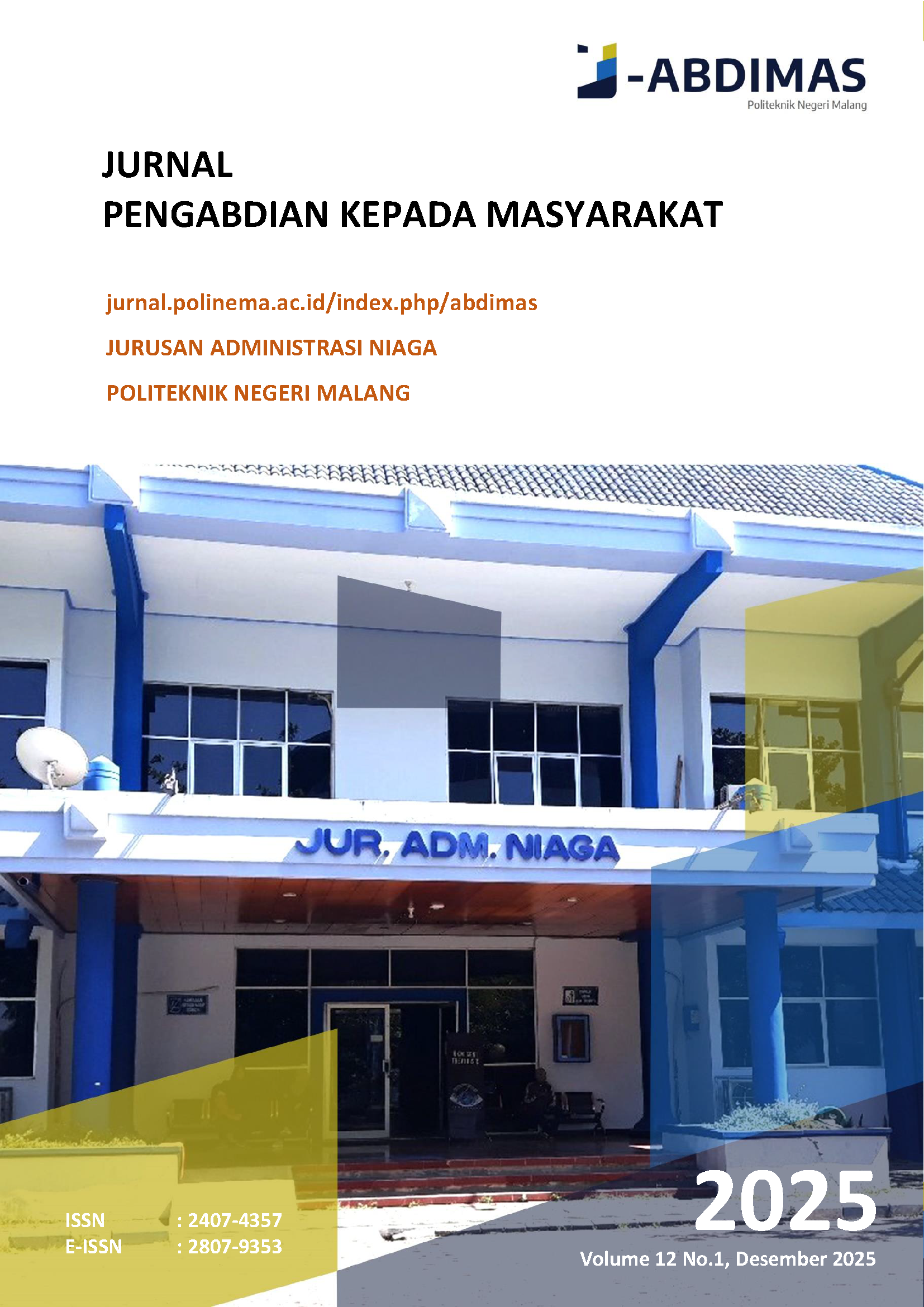Peningkatan Daya Jual Produk Anyaman Bambu Desa Kanyoran Kabupaten Kediri Berbasis WEB
DOI:
https://doi.org/10.33795/abdimas.v12i1.6413Keywords:
Anyaman Bambu, Aplikasi Digital, Kerajinan, Pemasaran Digital, Sistem WebAbstract
This research aims to evaluate the web system training conducted in Kanyoran Village, Kediri Regency, focusing on the development of applications that benefit the community. The issue faced by the villagers is the lack of understanding and skills in utilizing digital technology for marketing their craft products, particularly bamboo weaving. In response to this challenge, the research employs a step-by-step training method, beginning with an introduction to the material and extending to the use of hosting services. Over the course of two days, participants were equipped with practical skills through interactive teaching designed to enhance their knowledge and confidence in using digital applications. The evaluation results indicate that the majority of participants found the training material easy to understand, the developed application useful, and the hosting training sufficiently clear. The questionnaires filled out by participants revealed that 70% of respondents felt motivated to use the application for further marketing. Thus, the training successfully achieved its goal of improving the community's understanding and skills in leveraging digital technology. Recommendations for future activities include extending the training duration and providing more hands-on practice sessions to enhance participants' confidence in using the application, as well as incorporating advanced modules that cover deeper digital marketing strategies
References
Z. Vavian, N. Pratama, and S. Mutmainah, “Karakteristik Produk Kerajinan Bambu Karya Mujiana Di Desa Sumber Cangkring, Gurah, Kediri,” 2021. [Online]. Available: http:e/journal.unesa.ac.id/index.php/va
F. Fauziyah, P. N. Attarie, F. Nursandi, U. Santoso, and W. S. Astutik, “Pendampingan Kelompok Usaha Kerajinan Bambu Untuk Peningkatan Produktivitas UMKM Di Desa Pehkulon Kabupaten Kediri,” Jurnal ABM Mengabdi, vol. 10, no. 1, p. 1, Jun. 2023, doi: 10.31966/jam.v10i1.1201.
F. Fauziyah, “Tantangan UMKM dalam Menghadapi Revolusi Industri 4.0 Ditinjau dari Aspek Marketing dan Accounting,” JMK (Jurnal Manajemen dan Kewirausahaan), vol. 5, no. 2, p. 155, Jun. 2020, doi: 10.32503/jmk.v5i2.1008.
D. Sarmah, Bamboo In The Backyard. Notion Press, 2022.
Y. A. Erkol, Bamboo: a socio-material approach to past and present bamboo cultures. Technische Universitaet Berlin (Germany), 2021.
rang Umar Syarifuddin, G. Bata Ilyas, H. Mustafa, and A. Sani, “Strategi Pengembangan Usaha Kerajinan Anyaman Rotan dan Bambu melalui Pemasaran Online di Kecamatan Ma’rang Kabupaten Pangkep,” Bata Ilyas Educational Management Review, vol. 2, no. 2, pp. 1–24, 2022, doi: https://doi.org/10.37531/biemr.v2i2.198.
M. Wulandari, S. Wahyuni, and M. Zulianto, “Strategi Diversifikasi Produk Pada Umkm Kerajinan Bambu Di Desa Gintangan Kecamatan Blimbingsari Kabupaten Banyuwangi,” vol. 15, no. 1, 2021, doi: 10.19184/jpe.v15i1.19704.
M. Fitriani Nur Maghfiroh, D. Janari, S. I. Indrawati, and M. Ridwan Andi Purnomo, “Analisis SWOT untuk Digitalisasi Strategi Pemasaran Usaha Kecil dan Menengah Kerajinan Bambu,” Journal of Approriate Technology for Community Services, vol. 3, no. 2, pp. 1–11, Jul. 2022, doi: 10.20885/jattec.vol3.iss2.art5.
H. Mubarat, A. W. Viatra, and M. Patriansah, “Pelatihan Kerajinan Bambu sebagai Upaya Peningkatan Keterampilan dan Ekonomi Keluarga Di Kecamatan Sungai Lilin Kabupaten Musi Banyu Asin,” Lumbung Inovasi: Jurnal Pengabdian kepada Masyarakat, vol. 7, no. 2, pp. 164–173, Jun. 2022, doi: 10.36312/linov.v7i2.706.
U. Rahardja, N. Lutfiani, and M. S. Alpansuri, “Pemanfaatan Google Formulir Sebagai Sistem Pendaftaran Anggota Pada Website Aptisi.or.id,” SISFOTENIKA, vol. 8, no. 2, p. 128, Jul. 2018, doi: 10.30700/jst.v8i2.401.
Reeynaldi, “Analisis Pengaruh Kinerja Teknik Search Engine Optimization (SEO) Pada Website Pt. Jaya Bersama Saputra Perkasa,” 2018.
Z. Abidin and A. Mahatir, “Alat Monitoring Kehadiran Karyawan WPK Dengan Smartcard RFID Berbasis IOT Via Web Xampp,” SinarFe7, vol. 5, no. 1, pp. 28–32, 2022.
R. Maringka and C. Lumingkewas, “Designing User Interface (UI) And User Experience (UX) of a Sport Space Rental Application using Design Thinking Method,” CogITo Smart Journal, vol. 10, no. 1, pp. 192–203, 2024.
R. Gunawan, G. Anthony, and M. S. Anggreainy, “The effect of design user interface (UI) e-commerce on user experience (UX),” in 2021 6th International Conference on New Media Studies (CONMEDIA), IEEE, 2021, pp. 95–98.
H. W. Alomari, V. Ramasamy, J. D. Kiper, and G. Potvin, “A User Interface (UI) and User eXperience (UX) evaluation framework for cyberlearning environments in computer science and software engineering education,” Heliyon, vol. 6, no. 5, 2020.
Downloads
Published
Issue
Section
License
Copyright (c) 2025 Jurnal Pengabdian kepada Masyarakat

This work is licensed under a Creative Commons Attribution 4.0 International License.










